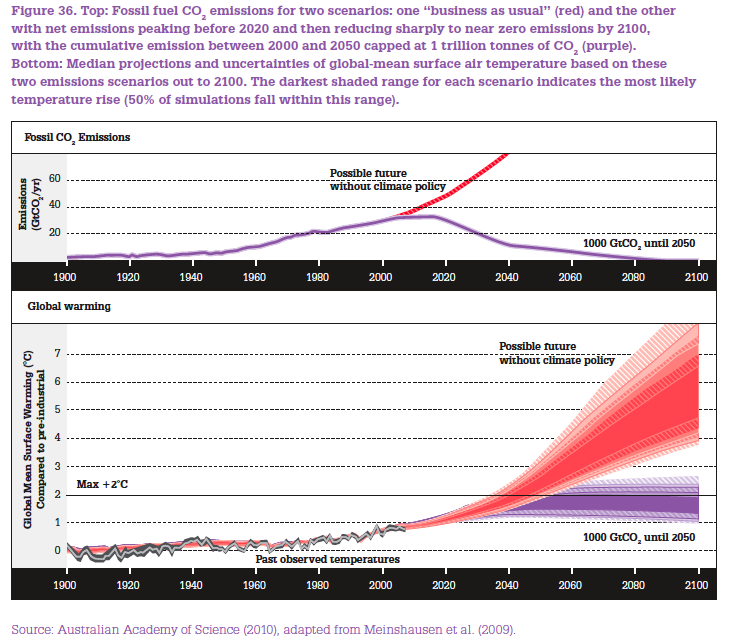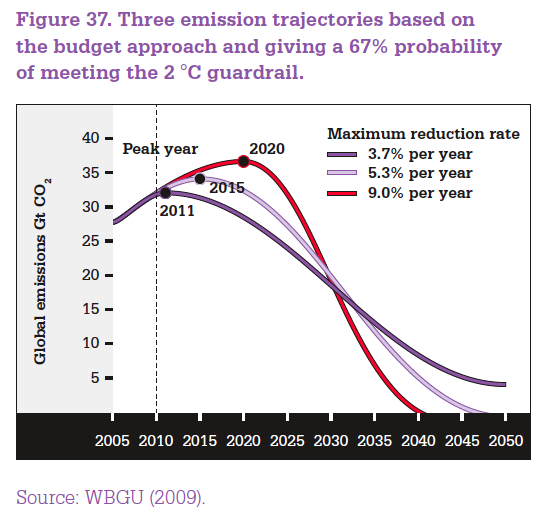
The Australian government established a Climate Commission which recently released a three chapter report entitled The Critical Decade. In Part 1, we examined Chapter 1 of the report, which summarizes the current state of climate science observational data. In Part 2, we examined Chapter 2, which discussed the risks associated with a changing climate. In Part 3, we will examine Chapter 3, which looks at the implications of the science on carbon emissions reductions. The quotes and bullets below come directly from the report, while the remainder is our commentary.
Because of the long atmospheric lifetime of carbon dioxide (CO2), the total amount of carbon emitted matters more than when it is emitted. Thus the report recommends examining the issue by using a budget approach, wherein a certain budget of CO2 emissions corresponds to a certain amount of eventual global warming.
According to the latest data, between 2000 and 2010 we emitted approximately 300 billion tons (gigatons, or Gt) CO2, so after 20% of the allotted timeframe, we're already over 30% of the way through the allotted emissions. Not a good start. However, although we're running out of time to reduce our emissions, the good news is that we're not out of time yet.
Once nice aspect of the budget approach is that as long as we're still below the allotted emissions, we still have a chance to achieve the budgetary goal. The figure below, taken from the report, shows that if we implement serious carbon emissions reductions policies soon and achieve a global emissions peak by about 2020, we can realistically meet the 1 trillion ton emissions budget by 2050. However, in a scenario without serious carbon reduction policies in place, we're looking at a potentially catastrophic warming of 4°C or more by 2100.
The report proceeds to discuss the fact that since we have already burned through over 30% of our allotted emissions by 2050, we're running out of wiggle room and need to act immediately.
The chapter discusses the fact that although the budgetary approach gives us a good degree of flexibility, the longer we wait to take serious emissions reductions steps, the steeper the global carbon emissions cuts will have to be:

Eventually if we wait too long, we will reach a point where the necessary annual emissions cuts are simply beyond our political and technological capabilities. This point is fast approaching, which is why it's so critical to start implementing serious climate policy immediately.
The report goes on to discuss the nature of different types of carbon offsets. Some offsets are sold as an equivalent amount of carbon uptake by ecological systems (i.e. funding the planting of trees, which absorb a certain amount of carbon). However, the report discusses that in the long run, these ecological systems are not as effective as direct emissions reductions because they don't represent permanent sequestration, and "the offset approach, if poorly implemented, has the potential to lock in more severe climate change for the future."
The key message here is that the most effective way to reduce CO2 emissions is to leave fossil fuels in the ground. While reforestation is very important, using it as an excuse to reduce fossil fuel-related emissions less quickly is a mistake. We need to do both.
In short, the scientific evidence discussed in the report indicates that we need to take significant steps to reduce global carbon emissions immediately. One decade into the 21st Century, we're already one-third of the way to the carbon emissions we're allotted by mid-century if we're to be confident we can limit global warming to 2°C, and as has recently been in the news, even that level of warming may be too high. Yet instead of cutting emissions, last year saw a new record high in human CO2 emissions. We're headed in the wrong direction, and need to reverse course immediately.
I'll leave the last word for the Climate Commission, because I think they did an excellent job summarizing the state of affairs in the report's final paragraph:
"As you’ve read in this report, we know beyond reasonable doubt that the world is warming and that human emissions of greenhouse gases are the primary cause. The impacts of climate change are already being felt in Australia and around the world with less than 1 degree of warming globally. The risks of future climate change – to our economy, society and environment – are serious, and grow rapidly with each degree of further temperature rise. Minimising these risks requires rapid, deep and ongoing reductions to global greenhouse gas emissions. We must begin now if we are to decarbonise our economy and move to clean energy sources by 2050. This decade is the critical decade."
Posted by dana1981 on Saturday, 11 June, 2011
 |
The Skeptical Science website by Skeptical Science is licensed under a Creative Commons Attribution 3.0 Unported License. |